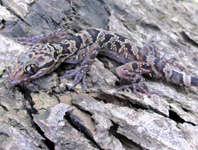Abstract
Charissa is a species-rich genus within the geometrid subfamily Ennominae, and is widely distributed in the Palaearctic and the Oriental regions; one species also occurs in the Nearctic. Their perfect adaptation to rocks on which they rest during daytime makes them sometimes difficult to tell apart on habitus. For that it is often necessary to analyze their genitalia. Since Sauter (1990), about 30 species, almost all European ones, have been newly combined from Gnophos Treitschke, 1825 to Charissa (Parsons et al. 1999). Currently, the genus is under revision by the authors of the present paper, and the genus name is under protection according to § 23.9.3. ICZN (Erlacher & Erlacher 2017).
References
Curtis, J. (1826) British entomology; being illustrations and descriptions of the genera of insects found in Great Britain and Ireland: containing coloured figures from nature of the most rare and beautiful species, and in many instances of the plants upon which they are found. John Curtis, London, 197 pp.
https://doi.org/10.5962/bhl.title.8148
Erlacher, S. & Erlacher, J. (2017) Case 3731 – Charissa Curtis, 1826 (Lepidoptera, Geometridae): proposed conservation by reversal of precedence with Hyposcotis Hübner, [1825]. Bulletin of Zoological Nomenclature, 74, 88–91.
https://doi.org/10.21805/bzn.v74.a022Hebert, P.D.N., Cywinska, A., Ball, S.L. & deWaard, J.R. (2003) Biological identifications through DNA barcodes. Proceedings of the Royal Society of London B, 270, 313–321.
https://doi.org/10.1098/rspb.2002.2218
Kimura, M. (1980) A simple method for estimating evolutionary rates of base substitutions through comparative studies of nucleotide sequences. Journal of Molecular Evolution, 16, 111–120.
https://doi.org/10.1007/BF01731581Parsons, M.S., Scoble, M.J., Honey, M.R., Pitkin, L.M. & Pitkin, B.R. (1999) The Catalogue. In: Scoble, M.J. (Ed.). Geometrid Moths of the World: A catalogue (Lepidoptera, Geometridae). Vol. 1 & 2. CSIRO Publishing, Collingwood & Apollo Books, Stenstrup, 1016 pp.
Rebel, H. (1901) Neue Lepidopteren aus Bosnien und der Hercegovina. Verhandlungen der kaiserlich-königlichen zoologisch-botanischen Gesellschaft in Wien, 51, 798–804.
Saitou, N. & Nei, M. (1987) The Neighbor-joining Method: A New Method for Reconstructing Phylogenetic Trees. Molecular Biology and Evolution, 4, 406–425.
Sauter, W. (1990) Zur Systematik der Gnophos-Gruppe (Lepidoptera, Geometridae). Nota lepidopterologica, 12, 328–343.
Staudinger, O. (1879) Lepidopteren-Fauna Kleinasien’s. Horae Societatis entomologicae Rossicae, 14, 176–482.
Wehrli, E. (1951) Une nouvelle classification du genre Gnophos Tr. Lambillionea, 51, 6–37.

